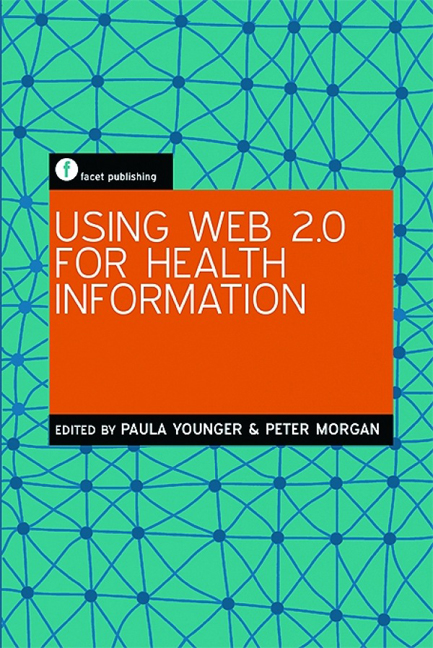Book contents
- Frontmatter
- Contents
- Preface
- Acknowledgements
- Contributors
- Glossary
- Introduction
- Part 1 The basics
- Part 2 Web 2.0 and the implications for health information
- 3 Emerging technologies in health, medical and nursing education
- 4 Supporting learners via Web 2.0
- 5 Supporting research
- 6 Crowdsourcing: the identification of content suitable for the developing world
- 7 Supporting patient needs: an overview of the potential role of Web 2.0 in patient and consumer information
- 8 Some ethical and legal considerations in the use of Web 2.0
- Part 3 Web applications in health information provision: some practical examples
- Part 4 The future
- Index
6 - Crowdsourcing: the identification of content suitable for the developing world
from Part 2 - Web 2.0 and the implications for health information
Published online by Cambridge University Press: 08 June 2018
- Frontmatter
- Contents
- Preface
- Acknowledgements
- Contributors
- Glossary
- Introduction
- Part 1 The basics
- Part 2 Web 2.0 and the implications for health information
- 3 Emerging technologies in health, medical and nursing education
- 4 Supporting learners via Web 2.0
- 5 Supporting research
- 6 Crowdsourcing: the identification of content suitable for the developing world
- 7 Supporting patient needs: an overview of the potential role of Web 2.0 in patient and consumer information
- 8 Some ethical and legal considerations in the use of Web 2.0
- Part 3 Web applications in health information provision: some practical examples
- Part 4 The future
- Index
Summary
Introduction: what is crowdsourcing?
According to Wikipedia (http://en.wikipedia.org/wiki/Crowdsourcing):
Crowdsourcing is a neologistic compound of ‘crowd’ and ‘outsourcing’ for the act of outsourcing tasks, traditionally performed by an employee or contractor to a large group of people or community (a crowd), through an open call.
In other words, you take a long-winded or complex task (that a computer typically cannot do well), break it down into smaller packets of work and get a group of people (the crowd) to each take a packet and work through it.
The most prominent recent example of crowdsourcing was the search for the American adventurer Steve Fossett. He went missing whilst flying over the Nevada desert on 3 September 2007. He hadn't filed a flight plan, so his aeroplane could have been anywhere within a 4- to 5-hour flying radius of the private airstrip known as Flying-M Ranch. On 8 September the first of a series of new high-resolution imagery was made available via the Amazon Mechanical Turk beta website so that users could flag potential areas of interest to be searched (http://en.wikipedia.org/ wiki/Steve_Fossett#Disappearance_and_search). The area was broken down into 300,000 squares, each measuring 278 feet square and covering the area where it was believed Fossett might have crashed. The principle in use was that users should look at individual squares for any signs of plane wreckage. By 11 September, up to 50,000 people had joined the effort and it was understood that each square had been viewed at least once. Unfortunately, there was no happy ending and on 29 October the site was closed, without any measurable success.
Other examples of crowdsourcing include: Facebook, using this approach to help create different language versions of the site; The Guardian newspaper's investigation into the MPs’ expenses affair in the UK (users sifted through 700,000 expenses claim forms); and, arguably, Wikipedia itself.
There have been some examples of using crowdsourcing in the medical world, but few have a high profile. Perhaps the most prominent is Medpedia (www.medpedia. com/), which is a medical version of Wikipedia. Amongst other prominent initiatives that include an element of crowdsourcing are PatientsLikeMe (www.patientslikeme.com/) and the People's Open Access Education Initiative (http://peoples-uni.org/).
- Type
- Chapter
- Information
- Using Web 2.0 for Health Information , pp. 73 - 78Publisher: FacetPrint publication year: 2011



